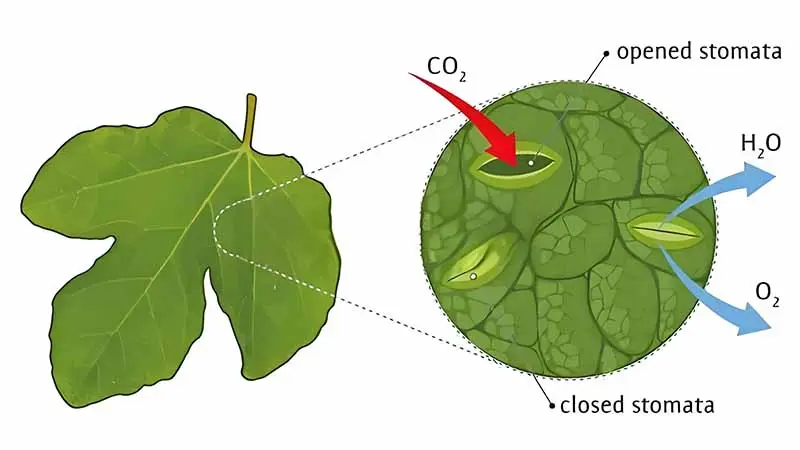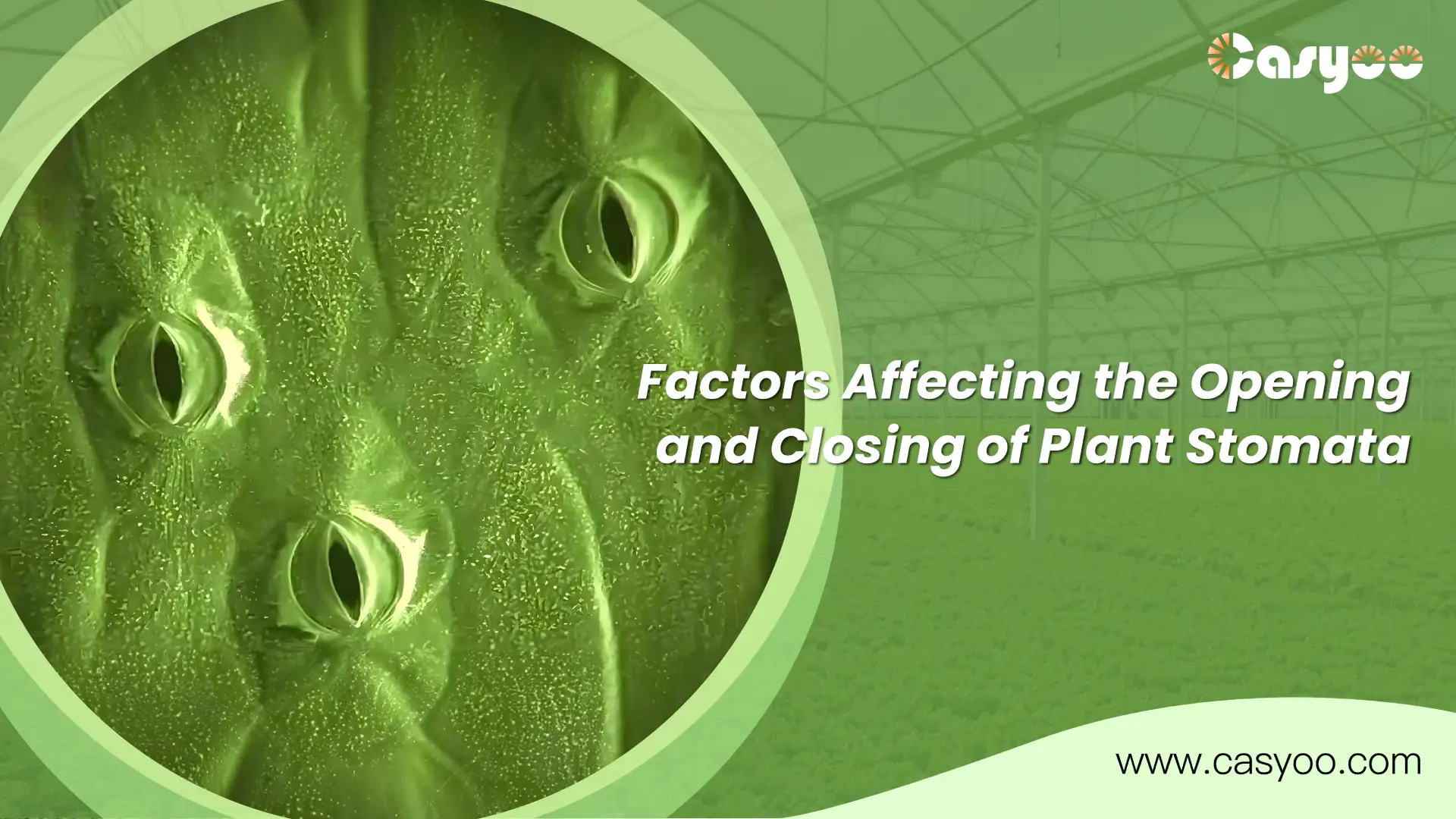Stomata of Plants
Plant stomata is essentially the abbreviation of stomatal complex, which is usually composed of a pair of kidney shaped or dumbbell shaped guard cells and the pores between them. Some plants also have one or several accessory guard cells around the guard cells that have different shapes and functions, forming stomatal complex together with the guard cells. Compared with mesophyll cells and epidermal cells, guard cells have a much smaller volume, so as long as a small amount of ions and water enter and exit, it will affect the opening and closing of stomata by causing a significant change in the turgor pressure of guard cells.
The Principle of Opening and Closing Pores

The opening and closing of pores is a very complex process. In general, plants keep their stomata open during the day and closed at night to minimize water loss and ensure CO2 supply.
The opening and closing of stomata in plant leaves are related to the structure of guard cells. Mature guard cells do not have intercellular filaments, but their cell walls have hard microfibrils and microtubules arranged radially outward from the pore side. Moreover, the cell wall on the inner side near the hole is thicker, while the cell wall on the outer side in contact with other cells is thinner. So, the outer cell wall of the guard cell can effectively respond to cell turgor pressure, causing cell expansion or contraction to regulate stomatal opening and closing and pore size changes. When the protective cells absorb water and increase their swelling pressure, the outer cell wall stretches more than the inner cell wall, while the relatively thicker inner cell wall stretches less. In this case, due to the traction of radially arranged microfibrils and microtubules, the cell wall on the pore side of the guard cell bends towards the outside, thereby widening the pores between the guard cells and opening the stomata. When the protective cell loses water and its turgor pressure decreases, the outer cell wall contracts faster and the stomata close.
Environmental Factors Affecting the Opening and Closing of Stomata
The movement of plant stomata is mainly controlled by genetic factors, temporal rhythms, and other factors. However, by sensing external environmental signals and converting them into internal signals, the opening and closing of plant stomata are also regulated and controlled by various environmental factors.
(1) Moisture Regulation
Defending cells are humidity sensitive cells that plants can use to respond to changes in the surrounding humidity environment. Pores can produce highly sensitive direct reactions. When a single leaf or whole plant is in a dry environment, the transpiration of the plant will increase due to the large vapor pressure difference between the leaves and the air. At this point, in order to prevent excessive dehydration of the plant body, stomatal conductance decreases and transpiration also decreases, ultimately reducing the possibility of plant damage due to atmospheric drought. In dry hot days with long periods of sunshine and no rain, as well as at noon in summer, stomatal conductance is relatively low. This is mainly due to the dehydration of guard cells, resulting in a decrease in volume and the straightening of cell walls; After prolonged rain, the cells absorb water and expand, and the protective cells are squeezed and unable to open, so they are also in a closed state during the day.
(2) Temperature Regulation
The vapor pressure inside plant leaves constantly changes with leaf temperature. With the increase of leaf temperature, the amount of water vapor that can be accommodated in the intercellular space of plants increases, and the evaporation effect on the surface of leaf mesophyll cells gradually saturates the vapor pressure in the intercellular space. When the steam pressure outside the leaves remains constant, an increase in the steam pressure difference between the inside and outside of the leaves will enhance the transpiration of the leaves. This is a self-protection mechanism of plants to maintain body temperature and avoid high-temperature burns through stomatal transpiration under high temperature conditions. Generally speaking, the degree of stomatal opening in plants increases with temperature, and the maximum stomatal opening occurs between 30 ℃ and 50 ℃.
(3) Light Regulation
Light is the main factor affecting the opening and closing of pores. A century ago, Darwin noticed that plants placed in front of windows had open stomata on the surface of their leaves facing the window, while those facing north had closed stomata; After flipping the plant, the previously closed stomata open while the previously open stomata close. After extensive research over a long period of time, it was found that the CO2 released during photosynthesis in cells under light reduces intracellular acidity. At a pH of around 7, starch is converted into pentose sugar by phosphorylase, increasing the water potential inside the cell and causing it to absorb water and expand. At this point, the thinner side of the stomatal cell wall elongates to a greater extent than the thicker side, causing the cell to bend and leading to the opening of the stomata. At sunset, the pH value of the cells increases, sugar is converted to starch, and the water potential inside the cells decreases, leading to dehydration and the closure of stomata. There are also studies showing that light energy promotes the formation of a large amount of potassium malate in cells, increases the water potential of stomatal cells, and promotes the opening of stomata. The response of stomata to light ensures that most plant stomata only open during CO2 assimilation, which allows plants to obtain as much CO2 as possible from the environment and minimize water loss. The reasonable use of grow light can adjust the opening and closing of plant stomata according to our needs.
(4) CO2 Regulation
Pores are the main channels for CO2 to enter the plant body, and their quantity and function are highly sensitive to changes in atmospheric CO2 concentration. The increase in atmospheric CO2 concentration leads to an increase in intercellular CO2 concentration in plants. In order to maintain the intercellular CO2 partial pressure always lower than the atmospheric CO2 partial pressure (about 20% to 30%), plants usually reduce intercellular CO2 concentration by adjusting the degree of stomatal opening and closing or reducing the number of stomata. At the same time, high concentrations of CO2 provide sufficient raw materials for photosynthesis in plants. As the concentration of photosynthetic products in plant guard cells increases, the relative decrease in cell water content due to large water consumption reduces the turgor pressure of guard cells, and stomata tend to close. Research has found that there is a feedback loop between CO2 concentration and stomatal conductance in the intercellular spaces of stomata: when the intercellular CO2 concentration decreases, stomata open and intercellular CO2 increases; On the contrary, stomata close and intercellular CO2 decreases. It can be seen that there is a negative correlation between intercellular CO2 and stomatal conductance. However, some studies suggest that the decrease in stomatal conductance and transpiration caused by the increase in CO2 concentration in plant leaves will inevitably lead to an increase in leaf temperature, which in turn promotes stomatal opening.
In addition, anatomical observations suggest that the opening and closing of stomata may not be solely the function of guard cells, but rather regulated as a whole. There are intercellular filaments between guard cells and adjacent epidermal cells, so it is believed that guard cells may obtain information from adjacent cells through intercellular filaments, thereby achieving regulatory activity.




